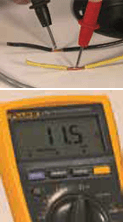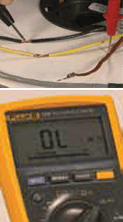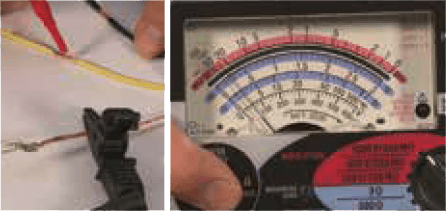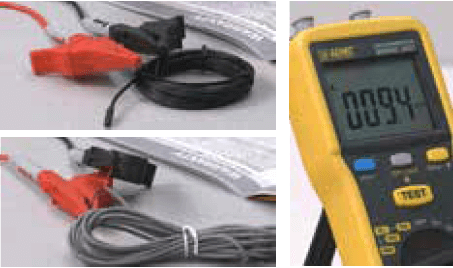Test 1–Conductor Resistance
 In order to perform the resistance test, you must set your multimeter for resistance measurement and take an ohms reading between the two power leads (120V power leads are black & yellow / 240V are black & red).
In order to perform the resistance test, you must set your multimeter for resistance measurement and take an ohms reading between the two power leads (120V power leads are black & yellow / 240V are black & red).
If the ohms reading taken on the two power leads varies significantly (10% or more) from the value printed on the spool, it means either:
- the cable has been damaged
- the measuring instrument is not set properly
- it is simply out of calibration.
The ohms measurement (along with the results of the rest of the tests) must be recorded in your Heating Cable Tests Log on page 30 of the
DITRA-HEAT Installation Handbook.
Test 2–Conductor and Ground Braid Continuity

The heating cable is protected by a ground braid. An electrical insulator prevents any contact between the braid and the two conductors. To make sure there is no contact between the braid and the two conductors, you must perform a continuity test.
Using the continuity test (buzzer logo) function of your multimeter, test your cable between the braid and one of the two power leads.
- If there is no continuity (if the test is successful), the multimeter will display, depending on the instrument used, either “OL ” for “over load” or “I” for “infinity”.
- Otherwise, if the test fails, neither “OL ”, nor “I” will be displayed and a warning tone will be heard.
Record your test results on the Heating Cable Tests Log on page 30 of the
DITRA-HEAT Installation Handbook.
Test 3–Insulation Resistance
This test is meant to detect very small breaks throughout the cable insulation.
These breaks often remain undetected during the continuity test since they are not necessarily
short circuits between the conductor and the ground braid.
Even small breaks can cause current leakage to ground.
Current leakage is usually detected by the mandatory ground-fault circuit  interrupter “GFCI” (i.e. a thermostat
interrupter “GFCI” (i.e. a thermostat
with integrated GFCI or a panel mount GFCI). When a current leakage is detected, the GFCI trips the circuit, thus disabling the floor heating system.
In order to perform the insulation resistance test, you must use a megohmmeter (MΩ), also known as a “megger”, to take an insulation measurement between the braid and one of the two power leads.
- Make sure the megohmmeter range is set at 1000 V
- The insulation resistance measurement must be equal to
or greater than 1 gigaohm (GΩ); 1 GΩ = 1000 MΩ.
Record your test results on the Heating Cable Tests Log on page 30 of the
DITRA-HEAT Installation Handbook.
Test 4–Temperature Sensor
Test the floor temperature  sensors using a multimeter to verify accuracy of the sensors.
sensors using a multimeter to verify accuracy of the sensors.
- Set the multimeter for resistance at 10K Ω +/- 2 (at room temperature) and take a reading between the sensor leads. The resistance will vary according to the temperature (i.e., the colder the sensor, the higher the resistance).
- Compare the measured values with the table of expected values and record in the Heating Cable Tests Log on page 30 of the
DITRA-HEAT Installation Handbook.

barney rigney says:
what is the maximum sustainable temperature of 240 volt heating cable
matthew@warmyourfloor.com says:
The maximum temperature you can set depends on the thermostat.
Most thermostats allow you turn the temperature up to between 90-99 degrees Fahrenheit.
Osbaldo Pacheco says:
If I install my own ditra heat system, do
I still get the 25 year warranty. I have a floor plan of my kitchen and I would place it around the new island.
Jacquelyn Sutterman says:
Hello Osbaldo,
Floor heat is a great choice for your kitchen! It’s becoming one of the most popular applications in our customers’ homes. Also, a membrane & cable system works great around fixtures like your island.
The manufacturer of DITRA-HEAT, Schluter-Systems, applies any warranty associated with their products. We suggest contacting them directly for the details on the length and extend of your coverage.
Warm Regards,
The Warm Your Floor Team